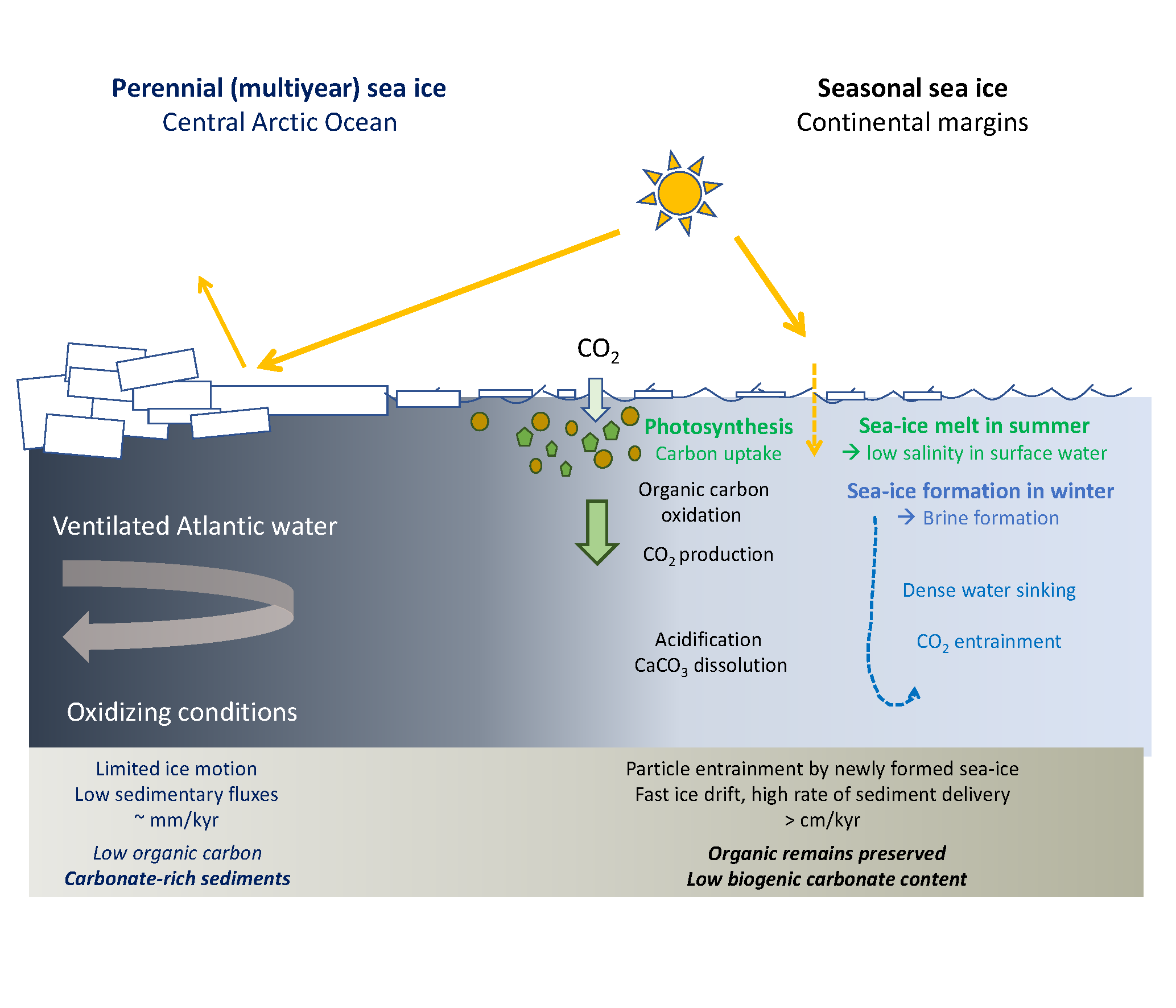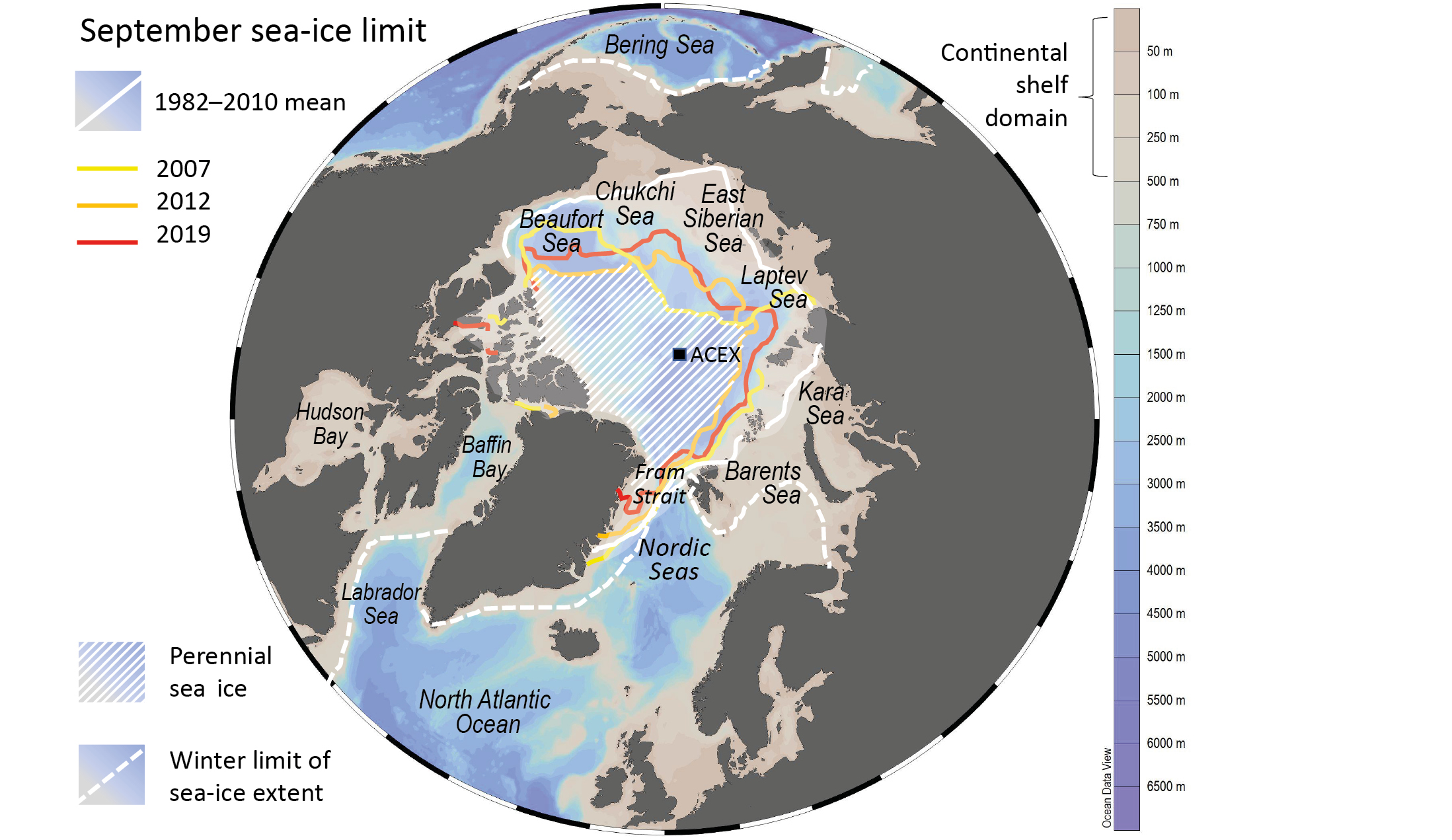- Home
- Publications
- PAGES Magazine
- Quaternary Arctic Sea-ice Cover: Mostly Perennial With Seasonal Openings During Interglacials
Quaternary Arctic sea-ice cover: Mostly perennial with seasonal openings during interglacials
de Vernal A & Hillaire-Marcel C
Past Global Changes Magazine
30(2)
94-95
2022
Anne de Vernal and Claude Hillaire-Marcel
Following the summer insolation peak triggering the present interglacial, the Arctic Ocean shelves experienced seasonal sea ice, whereas the central basin remained mostly perennially ice-covered. During the Quaternary, sub-perennial sea ice persisted, with short summer ice-free windows during the warmer interglacials.
Perennial vs. seasonal sea ice
Sea ice plays an important role in the climate system, not only because of the ice–ocean–albedo feedback, but also because it is a freshwater reservoir that modifies the ocean stratification when it forms or melts. From this viewpoint, the presence of perennial vs. seasonal sea-ice cover is particularly critical. The perennial sea ice that survives from one year to another has a relatively simple role in regional- to basin-scale climate and ocean conditions: it is thick (>3 meters), moves slowly, maintains high albedo through the summer season, and restricts exchanges of energy and gas at the ocean–atmosphere interface (Fig. 1). Presently, the west central Arctic Ocean is the only place where perennial sea ice maintains year after year (Fig. 2).
Seasonal sea ice is more complex and more elusive, as it melts in summer, following variable patterns and time windows. This results in a sea-ice extent varying from year to year and from one region to another (e.g. Chen et al. 2016). Thus, sea-ice extent experiences large amplitude and high frequency (interannual to interdecadal) changes related to atmospheric (Cai et al. 2021) and hydrographic (e.g. Ricker et al. 2021; Belter et al. 2021) patterns. Beyond the direct impact on sea-surface temperature through a reduced albedo, the summer sea-ice melting lowers the sea-surface salinity and enhances the stratification of upper water masses, which in turn fosters freezing and sea-ice formation with the atmospheric cooling during the following fall–winter seasons.
Furthermore, seasonal, first-year sea ice is thinner than multiyear ice. It moves at a higher speed along ocean currents and is thus more efficiently exported (Kwok et al. 2013). Hence seasonal sea ice is a highly dynamic component of the Arctic climate. In addition, its export from the Arctic Ocean into the North Atlantic, via the western Fram Strait, impacts the Atlantic Meridional Overturning Circulation (AMOC). As it is a source of freshwater, it enhances the stratification of the subarctic North Atlantic and thus may lead to reduced convection. However, the winter freezing of the low salinity surface waters leads to brine production and vertical mixing. Hence, the vertical convection that occurs close to the seasonal sea-ice edge plays a role in deep water formation, which implies that shifts in the limits of winter sea ice impact the locus and strength of AMOC turning points (Bretones et al. 2022).
For all the reasons summarized above, seasonal sea ice is a critical climate parameter, but it is an elusive one, due to its high variability in time and space.
Evidence for seasonal Arctic sea ice in the early–middle Holocene
 |
|
Figure 1: Sketch of oceanic, environmental and sedimentary processes under perennial and seasonal sea ice. Modified from de Vernal et al. (2020). |
Sea-ice environments characterized by open seawater conditions in summer experience high primary productivity of phototrophic organisms (such as diatoms and dinoflagellates). There are several types of biological remains providing indications of summer sea-ice-free conditions. They include microfossils and molecular biomarkers related to primary producers (de Vernal et al. 2013a), which permit the documentation of seasonal sea ice based on the analyses of sediment.
Sedimentary sequences from Arctic shelves of the Chukchi, East Siberian, Laptev, and Kara seas provide evidence for relatively high productivity under open summer sea-ice conditions, during the middle Holocene, from about 8000 to 4000 years ago (de Vernal et al. 2013b; Hörner et al. 2016; Stein et al. 2017). Some of the records show enhancement of sea ice during the late Holocene, which has lasted until the ongoing recent warming that has led to sea-ice decline.
In the central Arctic Ocean, sedimentation rates are very low, on the order of centimeters per thousand years or less (de Vernal et al. 2020; Hillaire-Marcel et al. 2017), precluding the establishment of high temporal-resolution records. Furthermore, the low organic carbon content of the sediment is accompanied by scarce primary productivity indicators. Nonetheless, relatively high concentrations of dinoflagellate cysts in early–middle Holocene sediment from the southeastern Lomonosov Ridge provide evidence for phototrophic productivity and episodic seasonal ice-free conditions off the Laptev Sea. In comparison, barren sediments from the polar and western sectors of the Lomonosov Ridge suggest that perennial sea ice prevailed throughout the whole Holocene (de Vernal et al. 2020). Such data provide evidence of a dipole pattern in sea-ice distribution during the early–middle Holocene, as seen in recent years, notably in 2007, 2012, and 2019 (Yadav et al. 2020; Fig. 2).
Assessing perennial vs. seasonal sea ice in the central Arctic Ocean from biological remains
Perennial sea ice is difficult to assess because it is based on negative evidence that relies on the absence of any indication for phototrophic, sea-ice-free productivity. Barren pelagic/hemipelagic sediments could be interpreted as indicative of perennial sea ice. However, cold water phototrophic taxa belong mostly to diatoms or dinoflagellates that yield organic biomarkers and/or microfossil remains made of biogenic silica (diatoms) or organic matter (dinoflagellate cysts), which do not necessarily preserve well. The undersaturation of the water column in silica prevents the preservation of diatoms down to the seafloor. Moreover, the subduction and circulation of North Atlantic waters in the Arctic Ocean, below the perennial ice cover, may cause oxidation of organic material, especially in the context of low sedimentation rates and high exposure to oxidizing conditions. As a result of low organic carbon fluxes, and low sedimentation rates, the sediments that blanket the floor of the perennially ice-covered Arctic Ocean are poor in organic carbon but rich in biogenic carbonates (Fig. 1). Hence, the surface sediments of the Arctic Ocean are often characterized by a rich carbonate fauna on the seafloor but are almost barren in organic remains that might have witnessed past phototrophic production (de Vernal et al. 2020).
The only positive indication of permanent sea ice that possibly exists is indirect: it comes from an ostracod species, Acetabulostoma arcticum, which lives as a parasite of a nematode occupying brine channels in multiyear sea ice (Cronin et al. 2012). This ostracod was present in the Amerasian Basin, western Arctic, for the last 400,000 years, including during the interglacial stages, which leads us to consider Arctic sea ice as a perennial feature since at least 400,000 years ago (Cronin et al. 2012).
The 2004 Arctic Coring Expedition (ecord.org/expedition302), during which long sequences near the North Pole were drilled (Fig. 2), may shed some light on the history of the Arctic sea ice. The record of organic-walled dinoflagellate cyst that may document phototrophic conditions revealed almost barren assemblages in the upper sequence encompassing the last two million years, suggesting perennial sea ice over the central Arctic Ocean throughout most of the Quaternary (Matthiessen et al. 2018).
Shifting from perennial to seasonal Arctic-wide sea-ice cover
Unraveling the long-term history of the Arctic sea ice is challenging. Sedimentary records from shelves yield biogenic material that allows us to document past sea ice from proxies, but only for the interval that followed the submergence of shelves accompanying the global sea-level rise of the last deglaciation. Sedimentary records from the deep basin yield older but equivocal proxy records, not to mention issues about their chronology (Hillaire-Marcel et al. 2017). Nevertheless, all data available converge toward perennial sea ice over the central Arctic basin during most, if not all, of the Quaternary. A positive indication for seasonal sea-ice openings during the early–middle Holocene transition, at least sporadically, exists for the southeastern sector of the Arctic Ocean (de Vernal et al. 2020), when summer insolation was still near its maximum. Other short-lived intervals with seasonally open water possibly occurred during earlier insolation maximums, but this is still not well documented. On the contrary, indirect evidence from ostracods suggests a resilient perennial sea-ice cover in the western Arctic, at least during the last three interglacials (Cronin et al. 2012). Hence, the evidence points to resilient perennial sea ice in the central Arctic Ocean during the Quaternary, perhaps interrupted by yet poorly documented short time windows of regional summer ice-free conditions. On geologic (pre-Anthropocene) timescales, the shift from seasonal to quasi-permanent perennial sea ice probably occurred before the Pleistocene. In that context, the recent trend toward seasonal sea ice over a large part of the Arctic Ocean is exceptional, with unavoidable consequences on the climate–ocean system.
affiliation
Geotop, University of Quebec in Montreal, Canada
contact
Anne de Vernal: devernal.anne uqam.ca
uqam.ca
references
Belter HJ et al. (2021) Cryosphere 15: 2575-2591
Bretones A et al. (2022) J Climate 35: 109-124
Cai Q et al. (2021) J Clim 34: 9931-9955
Chen HW et al. (2016) J Geophys Res Atmos 121: 14,433-14,455
Cronin TM et al. (2012) Nat Geosci 5: 631-634
de Vernal A et al. (2013a) Quat Sci Rev 79: 1-8
de Vernal A et al. (2013b) Quat Sci Rev 79: 111-121
de Vernal A et al. (2020) Proc Natl Acad Sci USA 117: 26,069-26,075
Hillaire-Marcel C et al. (2017) Geochem Geophys Geosyst 18: 4573-4585
Hörner T et al. (2016) Quat Sci Rev 143: 133-149
Kwok R et al. (2013) J Geophys Res Oceans 118: 2408-2425
Matthiessen J et al. (2018) Quat Sci Rev 192: 1-26
Ricker R et al. (2021) J Clim 34: 5215-5227


